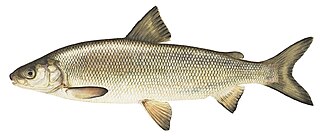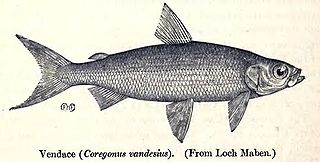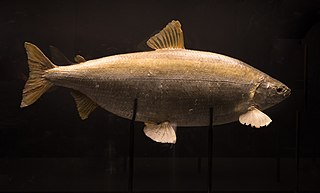
Coregonus is a diverse genus of fish in the salmon family (Salmonidae). The Coregonus species are known as whitefishes. The genus contains at least 68 described extant taxa, but the true number of species is a matter of debate. The type species of the genus is Coregonus lavaretus.

Coregonus lavaretus is a species of freshwater whitefish, in the family Salmonidae. It is the type species of its genus Coregonus.

The gwyniad is a freshwater whitefish native to Bala Lake in northern Wales.

Arctic cisco is an anadromous species of freshwater whitefish that inhabits the Arctic parts of Siberia, Alaska and Canada. It has a close freshwater relative in several lakes of Ireland, known as the pollan, alternatively regarded as conspecific with it, or as a distinct species.

The broad whitefish is a freshwater whitefish species. Dark silvery in colour, and like a herring in its shape, its distinctive features include a convex head, short gill rakers, and a mild overbite. It is found in the Arctic-draining streams, lakes, and rivers of far eastern Russia and North America. Its prey includes larval insects, snails, and shellfish. It is eaten by humans and brown bears.
The schelly is a living fresh water fish of the salmon family, endemic to four lakes in the Lake District, England. Its taxonomy is disputed with some recognizing it as a distinct species and others as a variant of the widespread Eurasian whitefish species Coregonus lavaretus. It is present in Brothers Water, Haweswater, Red Tarn and Ullswater, and the population seems stable in all of these except for Haweswater where it seems to be declining. The main threats it faces are seen to be water abstraction and cormorants, and the fish-eating birds are being culled from Haweswater. The International Union for Conservation of Nature has rated the conservation status of this fish as "endangered".

Coregonus vandesius, the vendace, is a freshwater whitefish found in the United Kingdom. Population surveys since the 1960s have revealed a steady decline and the fish is no longer present in some of its previous haunts but is still present in Bassenthwaite Lake and Derwent Water. The main threats it faces are eutrophication and the introduction of alien species of fish which eat its eggs and fry. The International Union for Conservation of Nature has rated its conservation status as "endangered".

The gravenche, also known as the Lake Geneva whitefish or the little fera, is a presumably extinct freshwater fish from Lake Geneva in Switzerland and France.

Coregonus fera, commonly called the true fera, is a presumed extinct freshwater fish from Lake Geneva in Switzerland and France.
Coregonus confusus is a freshwater whitefish from Switzerland. It is also known by its native Swiss German common name, spelled pfärrit, pfarrig, and pfärrig. It was described as Coregonus annectens confusus by Victor Fatio in 1885 from syntypes which have been lost in 1902. The species is rare and only known with certainty from Lake Biel. There is also a possibility that it might occur in Lake Neuchâtel. It vanished from Lake Murten in the 1960s due to eutrophication and water level management.

The peled, also called the northern whitefish, is a species of freshwater whitefish in the family Salmonidae. It is found in northern Europe and Asia.

The humpback whitefish, also referred to as the bottom whitefish, the Arctic whitefish or the pidschian, is a species of freshwater whitefish with a northern distribution. It is one of the members in the broader common whitefish complex, or the Coregonus clupeaformis complex. This fish lives in estuaries and brackish water near river mouths, in deltas and in slowly running rivers, in large lakes with tributaries, and floodplain lakes. It can migrate long distances upriver for spawning.
Coregonus trybomi is a freshwater whitefish in the family Salmonidae. It is a spring-spawning type of cisco, which probably has evolved from sympatric vendace independently in a number of Swedish lakes. Only one of those populations survives, and it is therefore considered Critically Endangered by the IUCN Red List. The status of Coregonus trybomi as a distinct species is however questionable. By Swedish authorities it is treated as a morphotype or ecotype, not an independent species. It was listed as "Data Deficient" in 2010 but excluded from the national red list in 2015.
Coregonus albellus, also called the autumn brienzlig, is a species of whitefish belonging to the family Salmonidae. It is endemic to Lakes Thun and Brienz in Switzerland's Interlaken region, where it is pelagic in deep water. The maximum length recorded for this species is 26.0 centimetres (10.2 in).

Coregonus alpinus is a species of freshwater whitefish in the family Salmonidae. It is endemic to Lake Thun, in Switzerland's Interlaken region, where it is found in deep water. The maximum length recorded for this species is 25 centimetres (9.8 in). It feeds on chironomids and other bottom-dwelling invertebrates. It is known as the kropfer, a name also applied to the probably extinct species Coregonus restrictus.
Coregonus bavaricus, the Ammersee kilch, is a species of freshwater whitefish endemic to Lake Ammersee in the German state of Upper Bavaria. A small, silver-colored fish, it typically lives between 60–85 m (197–279 ft) deep, though shallower in the summer months. In the early 20th century the Ammersee kilch was an important commercial species, but its population declined drastically in the 1930s onward due to overfishing and eutrophication of the only lake in which it is found. Today it is listed as Critically Endangered by the International Union for Conservation of Nature (IUCN) and may be on the verge of extinction.
Coregonus bezola was a species of freshwater whitefish in the family Salmonidae. It was endemic to the Lac du Bourget in Savoie, France where it was pelagic in deep water. The maximum length recorded for this species is 32.0 centimetres (12.6 in). It is known from specimens collected in the late 19th century, and was reported by fishermen to have disappeared in the 1960s. It spawned in January and February, on the muddy bottom of the lake, at a depth of 70 to 80 metres (230–260 ft).

Coregonus maraena, referred to in English as the maraene, maraena whitefish or the whitefish, is a whitefish of the family Salmonidae that occurs in the Baltic Sea basin - in the sea itself and the inflowing rivers, and in several lakes as landlocked populations. It is found in Denmark, Estonia, Finland, Germany, Latvia, Lithuania, Netherlands, Norway, Poland, Slovakia, Russia and Sweden. As of 2013, it has been listed as a vulnerable species by the IUCN and as endangered by HELCOM. It is an extremely important fish within the Baltic Sea ecosystem, both for population equilibrium and for the local diets of the surrounding human population. Due to a variety of factors, mostly overfishing, the maraena’s population dwindled to near-extinction levels. Thus, rampant repopulation was enacted to preserve this important fish.

Salvelinus profundus is a deepwater char species found only in deep areas of Lake Constance.
Coregonus widegreni, also called the Valaam whitefish, is a putative species of freshwater whitefish, a part of the common whitefish complex from Northern Europe. It is a demersal form of freshwater whitefish that feeds on benthic invertebrates. It spawns in late autumn, and can reach a length of 55 cm maximum. It is characterized by a low gill raker density.














